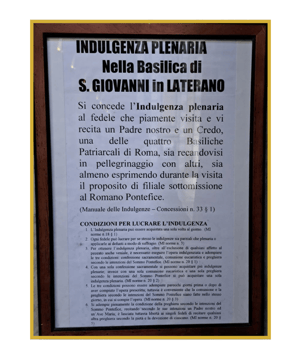The Plenary Indulgence
Contents
The Origins of Plenary Indulgences
Defining the Plenary Indulgence
How to Obtain the Plenary Indulgence
Plenary Indulgences During the Jubilee
In the Catholic religious sphere, the term Plenary Indulgence pertains to a specific doctrine and practice involving the Church's ability to intercede on behalf of believers. This intercession helps mitigate the temporal penances assigned for sins once their guilt has been absolved. This concept rests on two distinct aspects of sin: guilt and penance. While guilt is absolved through sacramental confession, the indulgence specifically addresses the penance, which is the residual repair or purification that remains even after forgiveness.


The Origins of Plenary Indulgences
Plenary indulgences reflect an era when spirituality and ecclesiastical practices were deeply intertwined with human affairs, with each religious act revealing a profound appreciation of redemption and penance. In the mists of early Christian history, penance was not simply a private ritual but a public journey of purification, a solemn march toward reconciliation with God and the community of faithful.
In these early communities, penitents donned sackcloth and covered themselves with ashes, manifesting their desire for conversion through these tangible symbols. Public penance was harsh, often prolonged and arduous, aimed at purifying the soul via physical suffering. These ancient customs were grounded in a theology that viewed sin as a blemish affecting the entire community, not merely the individual.
However, during the 10th and 11th centuries, the Church began to reshape these penitential practices into what is today recognized as the indulgence system. The premise that the Church could intervene and lighten the penances of individuals gained traction quickly. This shift was not just a doctrinal change but a transformation in the perception of divine mercy: the Church, embodying Christ, could extend, through its authority, not only the remission of sins but also relief from temporal penances via devotional acts such as prayer, charitable works, and pilgrimage.
This evolution underlined a profound trust in the Church's role as a mediator of divine grace, serving as a conduit between the divine and the human, authorized to dispense mercy. The landmark Bull of Pardon issued in 1294 by Pope Celestine V marked a pivotal moment in this progression. By this decree, the Pope extended the plenary indulgence to all the faithful who visited the Basilica of Collemaggio on specified dates, establishing a precedent for inclusivity and accessibility. His decision was groundbreaking: divine grace and remission of temporal penances were no longer limited to the select few or encapsulated within private rituals but were now accessible to every societal stratum, to every believer ready to embark on the penitential path.
Defining the Plenary Indulgence
Indulgence is classified into two categories: partial and plenary. A partial indulgence reduces temporal punishments to some extent, while a plenary indulgence completely eliminates them. The concept of this full grace has deep historical and theological roots, having evolved from the public penance practices of early Christian communities to becoming a mature expression of ecclesiastical mercy.
The Pardon of Assisi is one of today's most eloquent illustrations of a plenary indulgence. Each year on August 2, devotees from across the globe gather at the quaint Porziuncola, nestled within the Basilica of Santa Maria degli Angeli, to receive the "Pardon of Assisi." According to tradition, this plenary indulgence was granted by Christ himself to Saint Francis.
How to Obtain the Plenary Indulgence
To secure an indulgence, the faithful must engage in specified devotional practices established by the Church. These generally include Sacramental Confession, Eucharistic Communion, Prayer for the Pope’s Intentions, and a specific act such as a work of mercy or a pilgrimage.
The Sacrament of Reconciliation prepares the soul to receive God's full mercy by granting the penitent sacramental absolution for their sins, making it a crucial initial step towards a plenary indulgence. Following confession, the Eucharistic Communion acts as spiritual sustenance that unites the faithful with Christ and the Mystical Body of the Church. Finally, praying for the Pope’s intentions reflects unity with the universal Church and its earthly leader.
Detailed Guide to the Steps Required per the Manual of Indulgences
Sacramental Confession: A heartfelt confession of sins, with true repentance and an intent to reform, is required. It is recommended that this take place within twenty days before or after the indulgenced action.
Eucharistic Communion: Participation in Holy Mass and reception of the Eucharist are essential. This step is ideally completed on the same day as the indulgenced work.
Prayer for the Pope’s Intentions: Offer one Our Father and one Hail Mary for the Holy Father’s intentions, demonstrating unity with the global Church and its visible head.
Acts of Mercy: Engage in acts of charity or works of piety, such as visiting the sick, assisting the poor, or dedicating time to community service.
Absence of Any Attachment to Sin, Even Venial: This crucial requirement, often misunderstood or underestimated, necessitates a heart completely detached from sin (i.e., a deliberate detachment from sin, even after seeking forgiveness).
Specific Works: These may include pilgrimage to holy sites, participation in spiritual retreats, or other devotional practices as designated by the Church for the Jubilee.
Each of these steps, as directed in the Manual of Indulgences, deepens a believer's spiritual commitment and enhances their journey towards divine grace, illustrating the power and mercy inherent in the act of indulgence.
Plenary Indulgences During the Jubilee
During the Jubilee, the granting of indulgences takes on a particularly celebratory and universal aspect. The Jubilee is marked by various initiatives and traditions, notably the opening of the Holy Door in the Basilicas of Rome and in other selected churches globally. Walking through the Holy Door during the Jubilee is a symbolic act loaded with deep spiritual meaning, closely linked to the concept of indulgences, representing a pinnacle of the Jubilee pilgrimage.
The practice of indulgences allows the faithful to both express and deepen their spiritual commitment, serving as a conduit between divine mercy and each individual's journey of faith. In a Holy Year, the practice of granting indulgences is amplified and becomes a central focus for the faithful, who participate in pilgrimages and walk through the Holy Door as a tangible expression of their quest for grace and spiritual renewal.
Drop us a line
Follow us
Discover the Jubilee
Experience the Jubilee
Jubilee locations
Get ready for the Jubilee
Rome and the Jubilee
